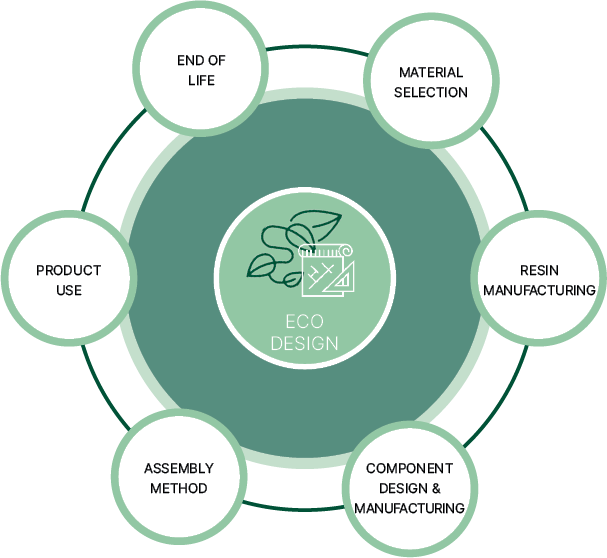Nolato’s eco-design model aims to optimize a product’s overall environmental impact.

ENVIRONMENTAL RESPONSIBILITY
Nolato’s eco-design model
Nolato’s eco-design comprises six strategic areas:
1.Material selection
Plastic often has a smaller footprint than glass and metal. And there is also a big difference in carbon footprint between different types of plastic. Different types of plastic are chosen depending on a product’s area of application (pressure, temperature, tensile strength, dynamics/vibration, etc.). Nolato seeks to find new versions of basic materials with a smaller carbon footprint that can replace traditional technically advanced materials that are often both more expensive and have a larger carbon footprint.
2.Resin manufacturing
The assessment of raw materials for the production of materials, i.e. what is used as a basis for the manufacture of the chosen type of plastic, is key to optimizing a product’s overall carbon footprint. This assessment aims to find alternatives to fossil raw materials, such as bio-based or materials that have been recycled, ether mechanically or chemically. The location of the raw material’s production is also considered to optimize transportation. Factors considered include renewable energy used in the product’s manufacture, as the source of energy for production is highly significant.
3. Component design & manufacturing
Design is key to optimizing weight and injection molding for a given function specification (strength, lifespan, etc.). Lower weight means less resource usage, as less material can be melted and cooled more quickly, making for a more efficient manufacturing process. The efficiency and quality of molds, machinery and other equipment are other crucial factors. Molds are designed for optimal cycle time, and great importance is placed on isolating sections that need to be heated from channels that cool another. The choice of other equipment is also crucial, as the unit that controls the temperature in the different sections of a mold has
a significant impact on overall energy use in injection molding. The manufacturing location, i.e. the region and country, and which type of energy is used in production also has a major influence on the carbon footprint.
4. Assembly method
The assembly of components to make a finished product can be done in numerous different ways. The method of assembly is influenced by the desired technical lifespan and the product’s area of use and design. A judgement is made between speed (=cost) of assembly and the ability to disassemble the product for repair, upgrade or refurbishment, which are significant factors for climate impact and a circular economy.
5. Product use
This stage assesses whether it is a passive or active product, which is mainly the responsibility of Nolato’s customers. An active product means that it continues consuming resources, such energy, over its useful life. A fossil-based vehicle, for instance, has a significant carbon footprint when it is used, whereas an electric vehicle charged with renewable electricity has a much smaller carbon footprint when used.
6.End of life
Circularity, i.e. the ability to recycle materials, is an important factor in optimizing a product’s environmental footprint. The main consideration in this regard is whether the product can be upgraded or refurbished to extend its useful life. A factor to consider in recycling is whether a component could be manufactured in a ‘mono-material’, i.e. when a component essentially consists of material that makes it possible to recycle instead of recovering energy.
